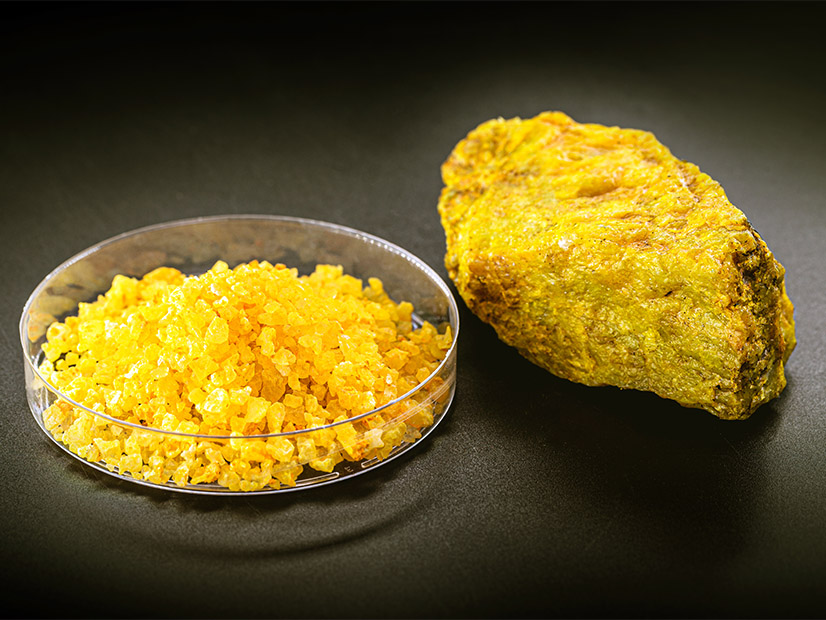The U.S. Department of Energy is putting $500 million from the Inflation Reduction Act into the buildout of a domestic supply chain for the high-assay, low-enriched uranium (HALEU) needed to deploy and power advanced nuclear reactors, according to a request for proposals released Jan. 9.
HALEU is uranium that is enriched 5 to 20% with U-235, the isotope needed to sustain a chain reaction that can produce energy, versus low-enriched uranium (LEU) that is enriched only up to 5% and is used in the existing light-water reactors in the U.S. The higher enrichment levels allow for reactors with “smaller and more versatile designs with the highest standards of safety, security and nonproliferation,” according to the RFP announcement.
The RFP is the second of two focusing on the key processes involved in HALEU production: mining, milling, enrichment and deconversion, which is the process of converting enriched uranium into usable fuel. The previous RFP, issued in November, will provide funding for deconversion facilities, while the current request will offer contracts for enrichment, which will include mining and milling.
Focusing on the domestic enrichment part of the process, DOE will award one or more contracts that will run for at least 10 years, with a minimum order valued at $2 million. While the RFP says that mining and milling activities may occur in North America at large or in “allied or partner” nations, actual enrichment and storage of the HALEU must be located in the U.S.
Also, the RFP specifically notes that any HALEU produced under these DOE contracts must not “negatively impact the existing baseline uranium production capacity currently supplying the U.S. domestic nuclear industry.”
Proposals are due March 8.
“Nuclear energy currently provides almost half of the nation’s carbon-free power, and it will continue to play a significant part in transitioning to a clean energy future,” Energy Secretary Jennifer Granholm said in the RFP announcement. “A robust HALEU supply chain” will strengthen “our national and energy security.”
At present, the only commercial source of HALEU is a state-owned company in Russia, and lack of a domestic supply threatens DOE’s Advanced Reactor Demonstration Program, which is supporting the development of two advanced reactors with $2.5 billion in funding from the Infrastructure Investment and Jobs Act.
Both projects will need HALEU, and the lack of a domestic supply has already been cited as potentially causing a two-year delay in the completion of one, the Natrium reactor being developed by the Bill Gates-founded TerraPower.
A DOE-funded demonstration project in Ohio began producing small amounts of HALEU in October, but the department estimates that the U.S. could need up to 40 metric tons by 2030, with more than that required each subsequent year.
The RFP is one more piece of the U.S. commitment to reviving the domestic nuclear industry and ending its dependence on Russian uranium in the wake of the war in Ukraine. At the 28th Climate Change Conference of the Parties (COP28) in December, the U.S. and more than 20 other countries pledged to triple nuclear power around the world by 2050.
In a second COP28 announcement, the U.S. joined Canada, France, Japan and the U.K. in plans to mobilize $4.2 billion in public and private funds over the next three years “to establish a resilient global uranium supply market free from Russian influence and the potential to be subject to political leverage by other countries.”
The announcement also encouraged “nuclear electricity generating utilities or direct nuclear energy industrial end-users of like-minded nations to develop [a] long-term supply strategy that signals and provides confidence to the industry to make the relevant investment to increase their capacity.”
Building Confidence
However, building private sector confidence in the emerging HALEU market may take more than DOE’s initial $500 million commitment, according to a recent analysis from the nonprofit Nuclear Innovation Alliance (NIA).
A successful buildout may require between $1.5 billion and $2.9 billion, said co-author Patrick White, NIA’s research director.
“The $500 million is a really, really good down payment,” he said. “But if you want to create a market signal [that] the federal government could support or help ensure that there’d be sufficient demand — let’s say 10 metric tons per year for a period of 10 years … that’s where you start getting appropriation needs on the order of a couple of billion dollars.”
One key to establishing a domestic supply chain while driving down costs might be leveraging existing, commercially produced LEU as feedstock for HALEU. “Use of lower-cost LEU enrichment services as part of the HALEU production process significantly reduces the overall cost of HALEU,” the report says.
White argues that using LEU as HALEU feedstock could be done without affecting the fuel supply for the existing U.S. nuclear fleet, especially if mined and milled uranium can be obtained from other North American or partner nations, as allowed in the RFP.
He also said that smart program structuring could “both protect the taxpayer and lower the total amount of money [needed] upfront.” A revolving fund, for example, could allow the government to “purchase HALEU and use that as kind of a guaranteed market signal and then sell [it] back to companies that are going to need it,” he said. That revenue could then be used to purchase more HALEU.
White sees the RFP providing DOE with a flexible framework “so they can work with different companies out there to determine what’s going to be the best pathway forward to really kind of get new … capacity brought online.”


